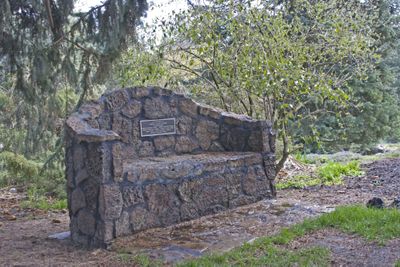Treks to find basalt benches rewarded with success

I walked along a road in Manito Park, veered up a dirt path to a natural area and stopped.
A bench sat in the midst of the dry grass, weeds and bushes. An old green wooden picnic bench or even a new cast-concrete and wood bench wouldn’t have surprised me, but this was an original design.Imposing black basalt rocks were mortared into a loveseat shape about 6 feet long and 4 feet high. The arms curved around into an arched back. It looked like a throne.
How could I have missed it? All my lifetime I’ve played in the park. I remember the tiny zoo. I played cowboys and Indians in the wild areas, scooped up pollywogs, skated in the winter, and kissed by the marble fountain. I walk here winter and summer.
I wondered why a bench was built in this dry, dusty place. No view, no shade. Curious, I asked and learned that not one but three benches had been commissioned as a memorial. Research for more information was a possibility, but I knew I would rather find them myself.
My plan divided the park into sections small enough for my daily walk. Since the bench had been hidden in an unlikely place, I reasoned the other two would not be in the Rose Garden, the Japanese Garden, the perennial beds or Duncan Garden; the natural areas might be best.
On my next walk I took the road that goes up high across the bridge. Keeping my eyes on the side areas required concentration. Perhaps I always walk with my eyes on the path. Think what I miss.
I almost missed the second bench. The dark bulk squeezed into tall bushes overhanging the edge of the grass, hard to see. The black rocks were mortared into the same design as the first one. Again, I found no names.
Where would I look for the third? It would take long hikes to search the green expanse of trees and grass along Grand Boulevard, the sunny play areas on 25th Avenue, and all the natural areas scattered through the park. I started on the north side of the pond where the ducks have left a snowfall of feathers. I hiked up to the old tennis court, then down to the summer picnic area, up the winter sliding hill and back through the tall old trees to the central part of the park. I saw no one, a rare solitude to find in the city. No rock bench either.
On the following Saturday, an October day with the warmth of summer, the park was a mecca for the neighborhood. This time I walked around the outside edges of Duncan Garden over to the streets on the east and west. Finally giving up, I needed a cool, shady place to sit. Then, when I wasn’t looking, I found the third bench. The branches of a huge Douglas fir draped around it; hostas, fuchsias and impatiens grew in the dark dirt. The black basalt bench looked just right there, even inviting. The third bench was found. (But right here, I am warning you, I am not going to spoil your fun by telling you exactly where any of the benches are.)
A bronze plaque with a long inscription was bolted to the middle of the back: “In loving memory of James N. and Ella K. Morris and their children – Fred M. and Margaret S. Morris, J. Robert and Margaret H. Prewitt, George W. and Blanche L. Hersman, Arthur J. and Pearl F. Morris, Glyde P. Morris, Ernest E. and Dortha W. Nimnicht, Manford D. and Betty M. Morris.”
Death was my first thought, but I reconsidered. These benches are not in memory of sad times. Instead I picture happy times, a family living close by with seven children who played in the park year after year. Those memorial benches inspired hours of play for me too.